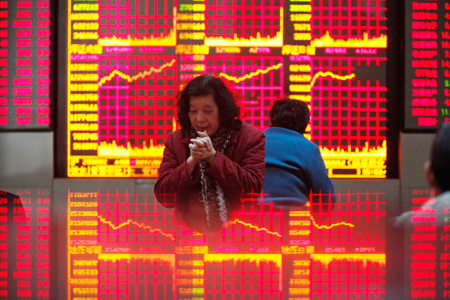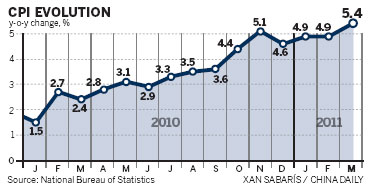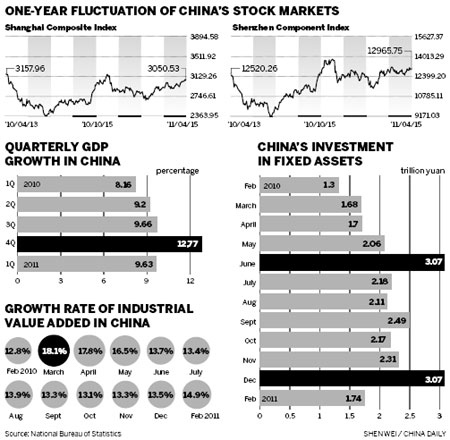Economy
Red-hot growth fuels economy
By Hu Yuanyuan and Tang Zhihao (China Daily)
Updated: 2011-04-16 09:34
 |
Large Medium Small |
|
 |
|
Investors monitor stock prices at a securities exchange company in Shanghai. Goldman Sachs Group Inc predicts the Shanghai-Shenzhen 300 Index will reach 3,500 points by the end of the second quarter and hit 4,000 points at the end of the year. [Photo / Bloomberg] |
BEIJING - China's economy continued its rapid expansion in March as the inflation index climbed to a 32-month high.
Meanwhile, GDP rose marginally faster than expected in the first quarter, indicating that the government still has much work to do to prevent the economy from overheating.
The consumer price index (CPI), a main gauge of inflation, rose 5.4 percent year-on-year in March, the National Bureau of Statistics (NBS) said on Friday. The growth rate is the fastest since July 2008 and exceeded most economists' forecasts of 5.2 percent .

"Imported inflation has strongly contributed to domestic price rises," Sheng Laiyun, an NBS spokesman, told a news conference.
Prices of crude oil, iron ore and grains rocketed to the highest level in two years in March. Food prices, which account for around one-third of the CPI basket, surged 11 percent from a year earlier, and housing costs jumped 6.5 percent year-on-year.
GDP rose 9.7 percent in the first quarter from a year earlier - beating economists' expectations of 9.5 percent - marginally lower than the 9.8 percent registered in the last quarter of 2010, according to the NBS data.
"The March data confirmed that China's economy is still overheating and the inflation risk is still very much to the upside," said Wei Yao, China economist from Societe Generale SA's Global Research and Strategy unit.
Fixed-asset investment rose 25 percent year-on-year in the first quarter, according to the NBS.
Fixed-asset investment statistics indicate continued strong investment from local governments, while the growth of central government-approved projects declined to the lowest level since 2005, Wei said.
According to Lu Zhengwei, chief economist with Industrial Bank Co, the government's tightening measures are not expected to ease before the third quarter of the year, because all the key economic indicators exceeded expectations.
"More tightening policies might be expected, with the required reserve ratios for banks likely to raised again, probably within two weeks, and one or two further rises in interest rates before the end of the second quarter," said Lu.
To soak up excess liquidity in the market, the central bank has raised the benchmark interest rate four times since October and has required the country's biggest lenders to lock up a record 20 percent of their deposits as reserves.
On Wednesday, Premier Wen Jiabao said that the government will use all the tools at its disposal to bring inflation under control.
"As these measures need more time to show their effect, I believe that the government could still meet the target it set for macro adjustment this year," said Jiang Jianqing, chairman of Industrial and Commercial Bank of China Ltd.
The government set this year's CPI target at 4 percent, a figure most analysts said will be difficult to achieve.
Jing Ulrich, chairman of Global Markets (China) at JP Morgan, said domestic and international food price volatility constitutes the main risk to the inflation outlook for the remainder of the year, as prices of agricultural produce are prone to surge in the event of adverse weather conditions.
"Inflation is likely to peak by mid-year, before moderating in the second half," Ulrich wrote in a research note.
Continuing wage inflation and policy-mandated rises in fuel prices and electricity tariffs should exert upward pressure on prices at the producer level, she added.
Stephen Green, China economist at Standard Chartered Plc, anticipated one more interest rate rise in the second quarter.
"We expect April and May CPI readings to be around the same level as in March but to peak again in June, at close to 6 percent year-on-year," said Green. He also raised the estimate for China's full-year GDP growth to 9.3 percent from 8.5 percent, taking account of the faster pace of growth at the start of the year.
The high level of CPI has affected every sector of business in China. Some are benefiting from the government's tightened monetary policy, while others are suffering.
"The hike in interest rates will boost the profitability of insurance companies because it will help them generate more revenue from fixed-income investment," said Dou Zeyun, an analyst at Ping An Securities.
In the face of Friday's figures, economists are discussing the possibility and timeframe of another interest rate hike. Stock market analysts said further rises will have a diminishing effect with relation to the stock market.
Li Xunlei, chief economist at Guotai Junan Securities, said there is likely to be less room for the central bank to tighten monetary policy, so the stock market is unlikely to take a serious hit.
According to a recent report from Goldman Sachs Group Inc, the Shanghai-Shenzhen 300 Index is expected to hit 3,500 points at the end of the second quarter, and 4,000 points by the end of the year.
To absorb excessive liquidity and control CPI, the central bank has also decided to apply a dynamic reserve ratio policy to lenders, by increasing the proportion of their capital that they have to keep as reserves.
Some analysts have that said small- and medium-sized banks will be most affected by the policy, because they may eventually find it impossible to lend to customers.
Analysts said life will be easier for the bigger banks that have a relatively lower reserve ratio and more capital.
Moody's Investors Service said the outlook for China's banking system remains stable because the domestic economy is expected to help banks produce strong earnings.

She Minhua, a banking analyst at Haitong Securities, said raising interest rates can be a positive for banks because it limits their loan potential and they are forced to be more selective when lending to companies.
Manufacturers of consumer goods have found that the rise in raw materials prices has imposed a heavy burden on their operations, as they are forced to either absorb the rise themselves or pass it on to customers, something which they say they have not done.
"In the past five years, we have not increased the prices of our products significantly," said Wang, a manager from Aokang Group Co, one of China's largest shoemakers in terms of sales.
"We have paid more attention to improving operational efficiency and introducing standardized production models to control costs," said Wang. "Higher efficiency means we can produce more goods in a shorter time period, and more orders will help us to maintain profits."
Meanwhile, the growing inflation pressure is also changing consumption habits.
"I used to spend 5 yuan (70 cents) buying two pieces of deep-fried dough stick and a cup of soybean milk in the morning, but since last month, I've had to pay 8 yuan for the same food," said Xin.
He added that an increase of 3 yuan may sound small, but the growth rate is a staggering 60 percent.
Wang Lin, a Beijing-based 28-year-old company executive, has given up taking trips to the shopping malls because the price of most dresses is more than 500 yuan.
"Now I only purchase clothes online where a suit or a dress will only cost between 100 and 200 yuan, which is reasonable given my salary," said Wang.
| 分享按钮 |



